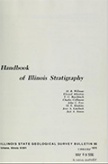Historical:Sonora Formation
Lithostratigraphy: Mammoth Cave Limestone Megagroup >>Sonora Formation
Chronostratigraphy: Paleozoic Erathem >>Mississippian Subsystem >>Valmeyeran Series
Allostratigraphy: Kaskaskia Sequence
Authors
Elwood Atherton, Charles Collinson, and Jerry A. Lineback
Name Origin
The Sonora Formation (Keyes, 1895, p. 320) is named for the now extinct village of Sonora, Hancock County, about a mile north of the type section of the formation.
Type Section
The type section of the Sonora Formation is located in the Sonora quarries (SE NW 31, 6N-SW).
Extent and Thickness
The Sonora crops out most widely in the Mississippi River bluffs and along tributary valleys in Adams and Hancock Counties. It is typically exposed at Jackson Cemetery, Hancock County (SE NW 14, 7N-8W), where it is more than 20 feet thick and consists of beds of argillaceous and dolomitic, cross-bedded sandstone alternating with sandy shale. The Sonora is generally about 20 feet thick between Niota and Hamilton, but elsewhere it is thinner, becoming only 2-3 feet thick in thick in the Warsaw area (Collinson, 1964).
Stratigraphic Position
Both Salem and St. Louis overlie the Sonora in places. The contact with the overlying St. Louis varies from conformable to erosional. In most localities where the contact is exposed, the lower part of the St. Louis is brecciated, possibly by the solution of a layer of gypsum or anhydrite. The Sonora grades laterally into the Salem Limestone and the upper part of the Warsaw Shale (Collinson, 1964). The Sonora lies within the conodont Taphrognathus variam--Apatognathus Zone (Collinson et al., 1971).
Description
In the type section the Sonora consists of about 20 feet of sandy, cross-bedded dolomite grades to porous, dolomitic sandstone. Although characteristically a sandy formation, the lithology varies laterally and vertically. The dolomite is arenaceous to argillaceous and sparsely fossiliferous, but fragments of fenestellid bryozoans occur throughout. The sandstone is generally light buff, dolomitic, argillaceous, and fine grained. The shale is generally greenish gray and sandy.
References
COLLINSON, CHARLES, 1964, Western Illinois: 28th Annual Tri-State Field Conference, Quincy, Illinois, Illinois State Geological Survey Guidebook Series 6, 30 p.
COLLINSON, CHARLES, C. B. REXROAD, and T. L. THOMPSON, 1971, Conodont zonation of the North American Mississippian: Geological Society of America Memoir 127, p. 353-395; Illinois State Geological Survey Reprint 1972-A.
KEYES, C. R., 1895, Geology of Lee County: Iowa Geological Survey, v. 3, p. 305-407.
ISGS Codes
| Stratigraphic Code | Geo Unit Designation |
|---|---|
